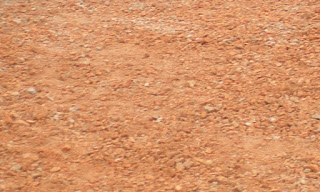Red and Yellow Soil
 If you are travelling in a remote location, then you can surely see red soil. Known for it's texture and colour, it has 90.47% of non soluble materials, 3.6% of iron content and 0.7% of magnesium. But it is lacking in Calcium Carbonate. It is distributed over an area of 3.5 lakh sq.km and are frequently found in the states of Tamil Nadu, Jharkhand, Orissa and Andhra Pradesh. In Andhra Pradesh, it is commonly seen in Seeshachalam, on the way to Tirupati Hills. If you are planning to cultivate using a part of red soil, then oil seeds, potatoes and some varieties of fruits maybe the right choice to grow with. It has an excellent response to it's nutrients especially fertilizers and provides the cultivator with enormous yield of millet. This is also the kind of soil used in movies, especially in action kind of scenes.
If you are travelling in a remote location, then you can surely see red soil. Known for it's texture and colour, it has 90.47% of non soluble materials, 3.6% of iron content and 0.7% of magnesium. But it is lacking in Calcium Carbonate. It is distributed over an area of 3.5 lakh sq.km and are frequently found in the states of Tamil Nadu, Jharkhand, Orissa and Andhra Pradesh. In Andhra Pradesh, it is commonly seen in Seeshachalam, on the way to Tirupati Hills. If you are planning to cultivate using a part of red soil, then oil seeds, potatoes and some varieties of fruits maybe the right choice to grow with. It has an excellent response to it's nutrients especially fertilizers and provides the cultivator with enormous yield of millet. This is also the kind of soil used in movies, especially in action kind of scenes.
 If you are travelling in a remote location, then you can surely see red soil. Known for it's texture and colour, it has 90.47% of non soluble materials, 3.6% of iron content and 0.7% of magnesium. But it is lacking in Calcium Carbonate. It is distributed over an area of 3.5 lakh sq.km and are frequently found in the states of Tamil Nadu, Jharkhand, Orissa and Andhra Pradesh. In Andhra Pradesh, it is commonly seen in Seeshachalam, on the way to Tirupati Hills. If you are planning to cultivate using a part of red soil, then oil seeds, potatoes and some varieties of fruits maybe the right choice to grow with. It has an excellent response to it's nutrients especially fertilizers and provides the cultivator with enormous yield of millet. This is also the kind of soil used in movies, especially in action kind of scenes.
If you are travelling in a remote location, then you can surely see red soil. Known for it's texture and colour, it has 90.47% of non soluble materials, 3.6% of iron content and 0.7% of magnesium. But it is lacking in Calcium Carbonate. It is distributed over an area of 3.5 lakh sq.km and are frequently found in the states of Tamil Nadu, Jharkhand, Orissa and Andhra Pradesh. In Andhra Pradesh, it is commonly seen in Seeshachalam, on the way to Tirupati Hills. If you are planning to cultivate using a part of red soil, then oil seeds, potatoes and some varieties of fruits maybe the right choice to grow with. It has an excellent response to it's nutrients especially fertilizers and provides the cultivator with enormous yield of millet. This is also the kind of soil used in movies, especially in action kind of scenes.
Comments
Post a Comment